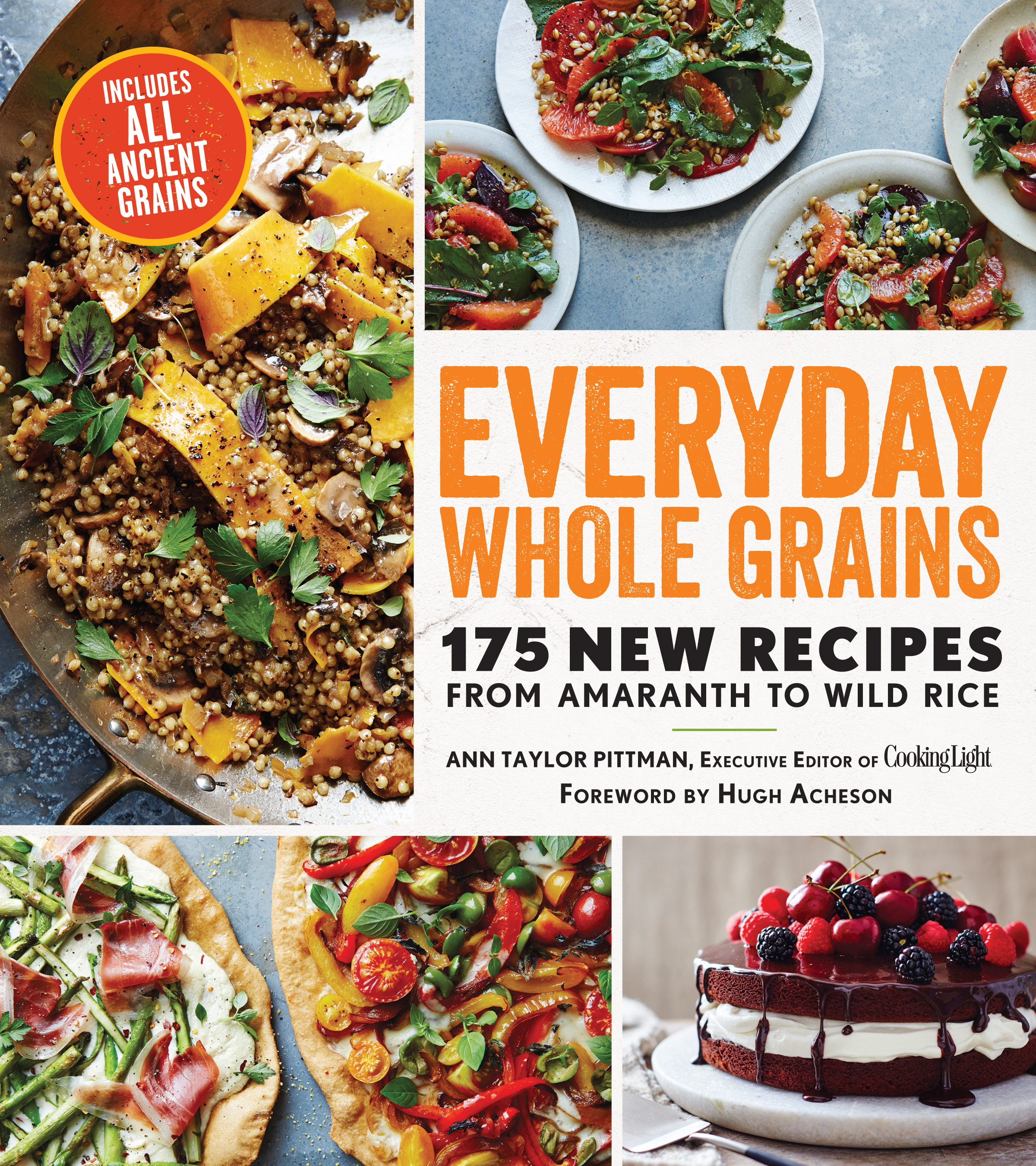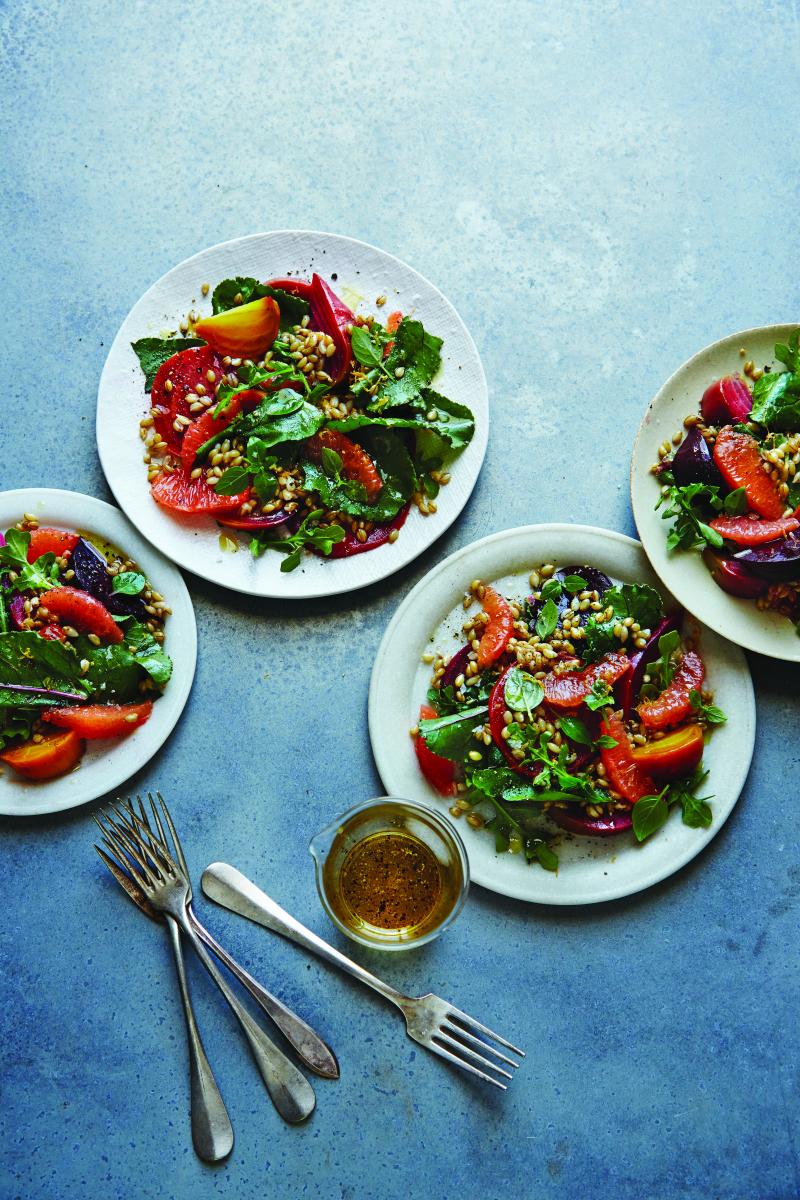Share This
Everyday Whole Grains:175 New Recipes From Amaranth to Wild Rice first graced our desks this March, and we haven’t been able to put it down since. So when we had the chance to catch up with the author, Cooking Light executive food editor Ann Taylor Pittman, we jumped at the opportunity. Our conversation follows below, edited and condensed for clarity.
Also, don’t miss the recipe for Smoked Barley, Beet, and Grapefruit Salad that Ann is kindly sharing with Whole Grains Council blog readers at the end of this article. (Kelly)
Whole Grains Council: You are obviously a champion for whole grains. What was your experience with eating and cooking whole grains while growing up, and how has it evolved over the years?
Ann Taylor Pittman: Growing up, there wasn’t much. I grew up in Mississippi. My mother is Korean and married a young man from Mississippi. We had a lot of biscuits and white bread and rice. I didn’t grow up eating many whole grains. In college I became more interested in eating healthier. To be honest, it was in part because I gained the freshman 15. I started college in 1987, so there wasn’t as much variety back then. I started eating whole wheat bread and it grew from there. I’ve been delighted at this explosion and availability of the interest in whole grains over the years.
My role as a mom and as the head cook in my family is a very powerful one. As such I am the nutrition gatekeeper of our family. The more I know about the benefits of whole grains, and whole foods in general, why wouldn’t I raise my children with whole grains as the default? The great thing is that now it’s so easy to eat this way. You don’t have to go to a specialty store to find quinoa or wheat berries. There are so many choices.
WGC: As different whole grains have become more readily available at mainstream supermarkets, what changes have you noticed in people’s relationship with whole grains over the past few years?
Ann: I think the interest in gluten free foods has opened people up to trying things like teff and quinoa that they might not have before. But I do think in terms of our magazine readership, and in general, people are much more open. Whole grains are everywhere. From a fast casual restaurant to a white tablecloth restaurant, you’re going to find whole grains. People are much more accepting just because they’re seeing them more.
WGC: We were happy to read that your kids have really embraced the whole grain lifestyle. What advice do you have for those whose families and kids seem less reluctant to try whole grains or are generally picky eaters?
Ann: Start with a dish that’s familiar, like chicken and dumplings, or meatloaf, or tacos, and offer a slight tweak by including whole grains. If you’re throwing too many new things at your family at once, you’re not going to be as successful. I’m not always a fan of hiding things, but sometimes I will let my kids take a few bites, realize that they like the food, and then explain exactly what’s in it. I want them to understand that what they’re eating is delicious and that it’s good for them.
WGC: Did you find that there are certain recipes where whole grains offer a distinct advantage over refined grains, from a culinary science standpoint, and how the recipe performed?
Ann: Yes! When I was doing a lot of the desserts, we realized that the flavor was just so good – it had more depth — it wasn’t just one note sweet. It was my husband who came up with this theory. When you think about white flour, its really bland. So what it does is end up diluting all the other flavors that you really want to amplify. But with whole grains, they already taste a little bit nutty, and so they don’t water the recipe down.
In fact, at the test kitchen we had people blind taste test chocolate chip cookies made from all purpose flour, regular whole wheat flour, and buckwheat flour. Unanimously, except for perhaps one dissenter, everyone’s least favorite was the one made with all purpose flour – it tasted kind of flat.
WGC: In your research for the book, did you come across any ancient grains that sounded exotic, but were actually quite versatile and simple to use?
Ann: The one that stands out for me is teff. It was quite unfamiliar to me. I had had it a couple of times, in the form of injera at an Ethiopian restaurant. The grain itself is so tiny and the flour behaves differently than any other flour I’ve worked with. I was a little intimidated, but I love it. The flavor is amazing. It almost has molasses-like qualities – a tangy bitter sweetness. The grain itself works so well in porridge and stews. And because the flour tends to get a bit viscous when wet, it makes these incredibly fudgy dense brownies. In the book I also did a fast version of the injera flatbread. The flavor is so great and it’s so quick and easy.
WGC: What advice would you give to people who think that cooking with whole grains can be too expensive?
Ann: Sometimes you can find great deals in the bulk section rather than buying packages off the shelf. But another thing that’s kind of a broader topic, is thinking of using whole grains to replace some of the meat in your diet. If you’re making a wonderful whole grain pilaf, you only need meat as an accent. In that way, you offset the cost of buying new grains by buying less meat.
WGC: Do you have any “go–to” whole–grain meals?
Ann: I love fried rice – it’s one of my favorite clean out the fridge sort of meals. I think that some people forget about brown rice as a whole grain, but brown fried rice is great. My kids do love pasta so we also turn to whole grain pasta a lot.
I’ve also been delighted by my complete conversion to whole grain flours in baking. Many whole grain baked goods call for 50% whole grain flour and 50% all purpose flour, so I thought, let me just see what happens if you go 100% whole grain. I’ve had such great luck and such great results. Whole wheat pastry flour is a godsend. Because it is ground so finely, I found that it works beautifully in cakes, cookies, and pie crusts. I just had great luck with that.
WGC: What is your recommendation for a simple change people can make to incorporate whole grains into their daily meal plan?
Ann: One of the best things you can do is be a weekend warrior and cook a big batch of whole grains on a Sunday and use it throughout the week. Because you already have it cooked, it’s a great starting point. If you have a big batch of wheat berries, you can throw them into salads and take to lunch, you can stir them into a soup, or you can treat it like fried rice. Doing a little bit of prep work ahead will put you ahead for the rest of the week.
SMOKED BARLEY, BEET, AND GRAPEFRUIT SALAD
From Everyday Whole Grains: 175 New Recipes From Amaranth to Wild Rice
Hands-on time: 25 minutes Total time: 25 minutes
The Cooking Light Test Kitchen perfected a stovetop smoking technique (which works on gas and electric stovetops) that has changed my life. I now keep wood chips and disposable aluminum foil pans on hand because you never know when you might want to smoke something… like barley! A sweet vinaigrette, earthy beets, and the bright citrus twang of grapefruit balance the robust smoky hit of the grains for a truly memorable salad. You can certainly make the salad without smoking the barley—just adjust the honey down to suit the milder flavor.
- Cooking spray
- ⅓ cup cherry or apple wood chips
- 1 cup cooked hulled barley
- 3 medium beets with greens
- 2 ½ tablespoons extra-virgin olive oil
- 1 ½ tablespoons champagne vinegar or white wine vinegar
- 2 teaspoons honey
- ½ teaspoon kosher salt
- ¼ teaspoon freshly ground black pepper
- 1 large pink or ruby red grapefruit, peeled and sectioned
- Pierce 10 holes on one side of the bottom of a 13 x 9–inch disposable aluminum foil pan. Coat pan with cooking spray. Arrange wood chips over holes inside pan. Spread barley onto opposite side of pan. Place hole side of pan over stovetop burner. Turn burner on high. When wood chips start to smoke, carefully cover pan with foil. Reduce heat to low; smoke 3 minutes. Remove pan from heat; carefully uncover. Rinse and drain barley under cold water; drain well.
- Trim beets, reserving greens. Remove tough stems from beet greens; tear greens to equal 3 cups, and set aside. Wrap beets together in a large piece of microwave-safe parchment paper. Microwave at HIGH 8 to 9 minutes or until tender; unwrap and cool slightly. Remove skins from beets; cut each beet into 8 wedges. Place beet wedges in a small bowl.
- Combine oil, vinegar, honey, salt, and pepper in a large bowl, stirring with a whisk. Drizzle 1½ teaspoons vinaigrette over beet wedges; toss to coat. Add barley and beet greens to bowl with remaining vinaigrette; toss gently to coat. Arrange barley mixture in a serving bowl; top with beets and grapefruit.
SERVES 4 (serving size: about 1 cup)
CALORIES 201; FAT 9.2g (sat 1.3g, mono 6.4g, poly 1.1g); PROTEIN 4g; CARB 28g; FIBER 6g; SUGARS 13g (est. added sugars 3g); CHOL 0mg; IRON 2mg; SODIUM 355mg; CALC 59mg




Add a Comment